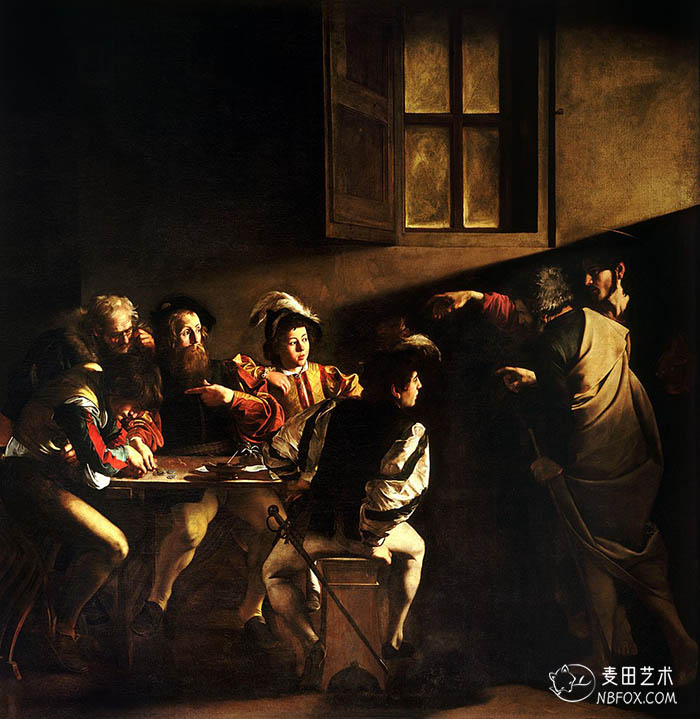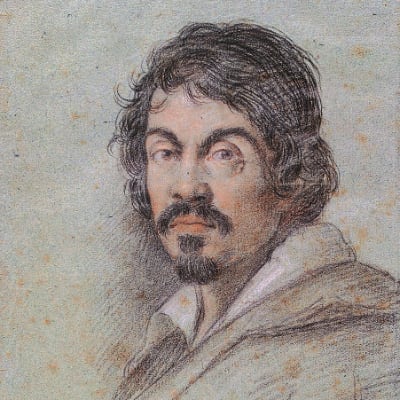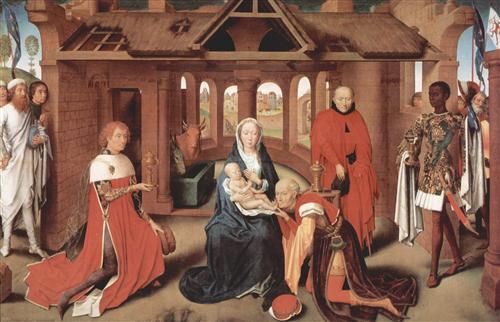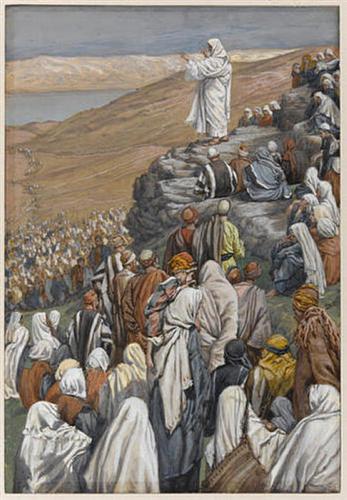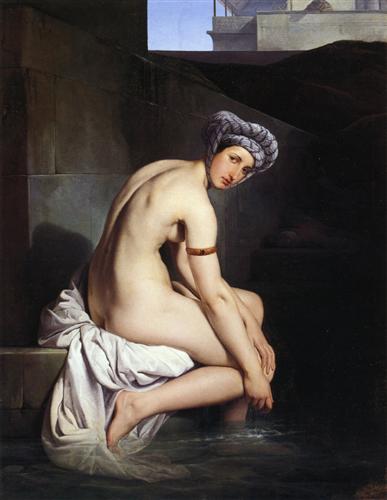图片尺寸:9770 × 10039 像素
作品名称:Calling of Saint Matthew
中文名称:召唤圣马太
创作者:卡拉瓦乔 Caravaggio
创作年代:1600
风格:巴洛克艺术
体裁:宗教画
材质:布面油画
现位于:San Luigi dei Francesi, Rome, Italy
实际尺寸:323 x 343 cm
版权信息: Public Domain(公有领域)
无水印高清图下载
图片尺寸:9770 × 10039 像素
图片大小:10.35 MB
图片格式:JPG
下载方式:百度网盘
下载地址:

作品介绍(机器翻译)
《召唤圣马太》是卡拉瓦乔的一幅画,描绘了耶稣基督激励马太跟随他的时刻。这幅画完成于1599-1600年,是为位于罗马的法国教区圣路易吉-德-弗兰西斯教堂的康塔雷利礼拜堂而作,现在仍保留在那里。它与卡拉瓦乔的另外两幅马太画作《圣马太殉难》(与《召唤》约为同一时期绘制)和《圣马太与天使》(1602年)一起悬挂。
委托
十多年前,红衣主教马修-科恩泰尔(意大利语:Matteo Contarelli)在他的遗嘱中留下了资金和具体指示,用于装饰一个与他的名字圣马太有关的主题的小教堂。小教堂的穹顶由已故的风格派艺术家朱塞佩-切萨里(Giuseppe Cesari)用壁画装饰,他是卡拉瓦乔的前雇主,也是当时罗马最受欢迎的画家之一。但当切萨里忙于应付皇室和教皇的赞助时,卡拉瓦乔的赞助人、同时也是圣彼得教堂(梵蒂冈教会财产办公室)的长官弗朗西斯科-德尔蒙特枢机主教出面干预,为卡拉瓦乔争取到了他的第一个重要的教堂委托,也是他的第一幅有几个人物的画作。
《召唤圣马太》挂在《圣马太殉难》的对面。虽然《圣马太殉难》可能是最早开始创作的,但据说《召唤圣马太》是最早完成的。这两幅侧面画--《召唤》和《殉道》--的委托日期是1599年7月,最后的付款是在1600年7月。在这两幅画之间的祭坛上,是《圣马太与天使》(1602)。
主题
这幅画描绘了《马太福音》中的故事(马太福音9:9)。"耶稣看见一个叫马太的人在海关的座位上,就对他说:"跟我来",马太就站起来跟着他。" 卡拉瓦乔描绘了税吏马太与其他四个人坐在一张桌子旁。耶稣基督和圣彼得已经进入房间,耶稣指着马修。一束光照亮了桌子上的人的脸,他们正看着耶稣基督。
圣马太的身份
关于画面中哪个人是圣马太,有一些争论,因为桌子上那个大胡子的惊讶姿态可以有两种解读方式。
大多数研究《召唤》的作者认为圣马太是那个大胡子,并认为他指着自己,似乎在问 "我?"以回应基督的召唤。如果考虑到本系列中的另外两部作品《圣马太与天使》和《圣马太的殉道》,这一理论就会得到加强。模仿圣马太的大胡子在这三部作品中都出现了,他在《圣马太与天使》和《圣马太的殉道》中都明确扮演了圣马太的角色。
最近的一种解释是,这个大胡子实际上是在指着桌子末端的年轻人,他的头是耷拉着的。在这种解读中,大胡子是在问 "他?"以回应基督的召唤,而这幅画描绘的是年轻的马修抬起头来见基督之前的那一刻。其他作家将这幅画描述为故意含糊其辞。
基督的身份
一些学者推测,耶稣被描绘成《新约》中的最后一个亚当或第二个亚当的称号。这显示在基督向马修伸出的手上。这几乎是米开朗基罗《创造亚当》中亚当手的镜像,米开朗基罗是卡拉瓦乔的同名作者。在《新约》中,耶稣和亚当之间有两次明确的比较。在《罗马书》5:12-21中,保罗认为 "正如因一人的悖逆,多人成了罪人一样,也要因一人的顺从,多人成了义人"(罗马书5:19,NIV)。在《哥林多前书》15:22中,保罗认为 "在亚当里人人都会死,在基督里人人都会活",而在第45节,他称耶稣为 "最后/终极/最后的亚当"。
风格
康塔雷利小教堂中相邻的三幅卡拉瓦乔的画作代表了一个决定性的转变,即从理想化的曼纳主义(切萨里是其最后的主要实践者)到卡拉瓦乔和安尼巴莱-卡拉奇所代表的更新的、更自然的和以主题为导向的艺术:他们在当时具有很大的影响力。
在某些方面,莱维的钱柜中大多数平民化的、几乎与真人大小相同的居民,即使不是以卡拉瓦乔其他画作中的那些人为原型,也是相当的,包括卡拉瓦乔著名的世俗风俗画《牌坊》(1595)。
在这幅画中,阴暗的环境和帆布窗似乎使桌子位于室内。基督给坐在那里的收税人的黑暗空间带来了真正的光明。这幅画记录了两个世界的碰撞--不朽的信仰的不可抗拒的力量,以及世俗的、浮华的、利维的世界。耶稣用一束光刺向他,他用一个明显的毫不费力的手势施加了一种不可避免的崇高的重力,不需要扳动世俗的肌肉。耶稣的赤脚是古典的简约,与那些被捆绑的会计形成对比;赤脚也可能象征着圣洁,就像人在圣地一样。与他在《大马士革路上的皈依》中对保罗的处理类似,卡拉瓦乔记录了一个日常事务被奇迹打断的时刻。在这个即将成为马太的人周围,要么是没有觉察的人,要么是没有被惊动的旁观者。
卡拉瓦乔的观众会看到耶稣指向马修时的手势与米开朗基罗的西斯廷教堂中上帝唤醒亚当时的手势有相似之处。顺着基督左臂的线条,马修似乎被邀请跟随他进入整个世界。"这种清晰的可读性,与许多曼纳主义绘画如此不同,......占了作品巨大的人气。" 然而,基督的手的位置反映了西斯廷教堂中亚当的位置;教会认为基督是第二个亚当。但是,基督不是像第一个亚当那样被赐予生命,而是赐予生命的人,召唤利未像马太那样获得新的生命。
作品介绍(原文)
The Calling of Saint Matthew is a painting by Caravaggio, depicting the moment at which Jesus Christ inspires Matthew to follow him. It was completed in 1599–1600 for the Contarelli Chapel in the church of the French congregation, San Luigi dei Francesi in Rome, where it remains. It hangs alongside two other paintings of Matthew by Caravaggio, The Martyrdom of Saint Matthew (painted around the same time as the Calling) and The Inspiration of Saint Matthew (1602).
Commission
Over a decade before, Cardinal Matthieu Cointerel (in Italian, Matteo Contarelli) had left in his will funds and specific instructions for the decoration of a chapel based on themes related to his namesake, Saint Matthew. The dome of the chapel was decorated with frescoes by the late Mannerist artist Giuseppe Cesari, Caravaggio's former employer and one of the most popular painters in Rome at the time. But as Cesari became busy with royal and papal patronage, Cardinal Francesco Del Monte, Caravaggio's patron and also the prefect of the Fabbrica of St Peter's (the Vatican office for Church property), intervened to obtain for Caravaggio his first major church commission and his first painting with more than a handful of figures.
The Calling hangs opposite The Martyrdom of Saint Matthew. While the Martyrdom was probably the first to be started, the Calling was, by report, the first to be completed. The commission for these two lateral paintings — the Calling and the Martyrdom — is dated July 1599, and final payment was made in July 1600. Between the two, at the altar, is The Inspiration of Saint Matthew (1602).
Subject matter
The painting depicts the story from the Gospel of Matthew (Matthew 9:9): "Jesus saw a man named Matthew at his seat in the custom house, and said to him, "Follow me", and Matthew rose and followed Him." Caravaggio depicts Matthew the tax collector sitting at a table with four other men. Jesus Christ and Saint Peter have entered the room, and Jesus is pointing at Matthew. A beam of light illuminates the faces of the men at the table who are looking at Jesus Christ.
Identity of Matthew
There is some debate over which man in the picture is Saint Matthew, as the surprised gesture of the bearded man at the table can be read in two ways.
Most writers on the Calling assume Saint Matthew to be the bearded man, and see him to be pointing at himself, as if to ask "Me?" in response to Christ's summons. This theory is strengthened when one takes into consideration the other two works in this series, The Inspiration of Saint Matthew, and The Martyrdom of Saint Matthew. The bearded man who models as Saint Matthew appears in all three works, with him unequivocally playing the role of Saint Matthew in both the "Inspiration" and the "Martyrdom".
A more recent interpretation proposes that the bearded man is in fact pointing at the young man at the end of the table, whose head is slumped. In this reading, the bearded man is asking "Him?" in response to Christ's summons, and the painting is depicting the moment immediately before a young Matthew raises his head to see Christ. Other writers describe the painting as deliberately ambiguous.
Identity of Christ
Some scholars speculate that Jesus is portrayed as the Last Adam or Second Adam as titled in the New Testament. This is displayed in Christ's hand as it reaches out towards Matthew. It is almost a mirrored image of Adam's hand in The Creation of Adam by Michelangelo, the namesake of Caravaggio. Twice in the New Testament, an explicit comparison is made between Jesus and Adam. In Romans 5:12–21, Paul argues that "just as through the disobedience of the one man the many were made sinners, so also through the obedience of the one man the many will be made righteous" (Romans 5:19, NIV). In 1 Corinthians 15:22, Paul argues that "as in Adam all die, so in Christ, all will be made alive," while in verse 45 he calls Jesus the "last/ultimate/final Adam".
Style
The three adjacent Caravaggio canvases in the Contarelli chapel represent a decisive shift from the idealising Mannerism of which Cesari was the last major practitioner, to the newer, more naturalistic and subject-oriented art represented by Caravaggio and Annibale Carracci: they were highly influential in their day.
In some ways, most of the plebeian, nearly life-sized inhabitants of Levi's money table are the equivalent, if not modeled by those persons in other Caravaggio paintings, including Caravaggio's famous secular genre painting of The Cardsharps (1595).
In this painting, the gloom and the canvassed window appears to situate the table indoors. Christ brings the true light to the dark space of the sitting tax-collectors. This painting records the collision of two worlds — the ineluctable power of the immortal faith, and the mundane, foppish, world of Levi. Jesus spears him with a beam of light, with an apparent effortless hand gesture he exerts an inescapable sublime gravity, with no need for wrenching worldly muscularity. Jesus' bare feet are classical simplicity in contrast with the dandified accountants; being barefoot may also symbolize holiness, as if one is on holy ground. Similarly to his treatment of Paul in the Conversion on the Way to Damascus, Caravaggio chronicles the moment when a daily routine is interrupted by the miraculous. Around the man to become Matthew are either the unperceptive or unperturbed bystanders.
Caravaggio's audience would have seen the similarity between the gesture of Jesus as he points towards Matthew, and the gesture of God as he awakens Adam in Michelangelo's Sistine Chapel. Following the line of Christ's left arm, it seems that Matthew is being invited to follow him into the world at large. "This clear legibility, so different from many Mannerist paintings, ... accounted for the work's enormous popularity." The position of Christ's hand, however, reflects that of Adam's in the Sistine Chapel; the Church considered Christ to be the Second Adam. But instead of being gifted life, as the first Adam was, Christ is instead the one who bestows it, calling Levi to a new life as Matthew. (来源:维基百科)
